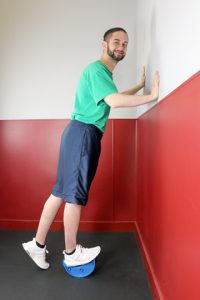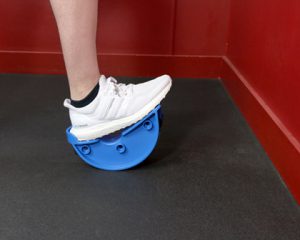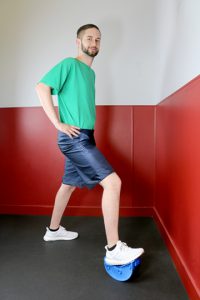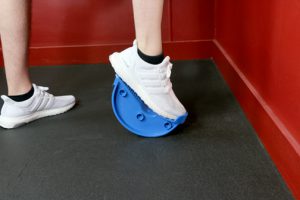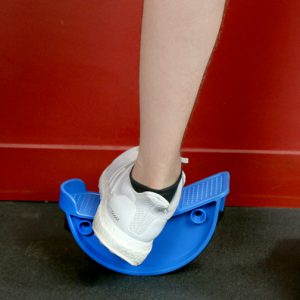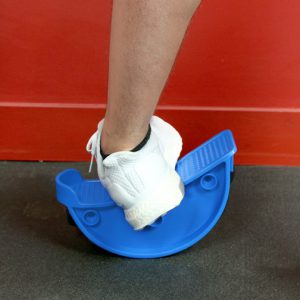Tight leg muscles are nothing new to distance runners or bodybuilders. However, if you’re freshly new to these activities you might wonder how these people keep up with their training when their legs can become too tight to move. The key is to stretch.
When leg muscles are deprived of stretching, they tighten and constrict the movement of the knee and ankle. This can feel very uncomfortable and can even put you at a risk for a sprain or tear. For this reason, it is important to maintain flexibility in your legs.
We developed the CanDo® Leg Stretcher to make stretching your leg muscles easy and effective. You can use it to easily stretch muscles in your legs, feet, and ankles. Below we listed several exercises you can do with the Leg Stretcher to make sure you stay mobile, even after leg day.
Before you begin:
- Consult with your healthcare provider or trainer before using the CanDo® Leg Stretcher
- Do not use the device on a wet surface, ice, gravel, loose stone, or sand
- Perform a light warm up before using the CanDo® Leg Stretcher
- Stand near a supportive structure, such as a wall or chair, when using the CanDo® Leg Stretcher
- Never stretch a muscle to the point of pain or bounce while stretching
- Wear a rubber-soled shoe while using the CanDo® Leg Stretcher
GASTROCNEMIUS (CALF MUSCLE)
The gastrocnemius muscle is a powerful muscle located in the back of the lower leg (the calf). It is a two-joint muscle that runs from just above the knee to the heel.
- Stand arm’s length away from a supportive structure. Place both hands on the structure and place a foot on the CanDo® Leg Stretcher.
- Stand with all your weight on the stretcher and lean slightly forward. Keep your other foot on the floor for support. Stand on the ball of your foot if needed.
- Lean slightly forward and keep your shoulders, hips, and ankle of the foot on the Stretcher in line with each other.
- Let your ankle pivot so your heel rocks back and your toes are pointing upward. You should feel the stretch in your upper gastrocnemius calf muscle. Hold for 30 seconds.
- Return to the starting position for five seconds. Repeat two more sets of 30 seconds with 5 second rests between sets. Repeat on the other leg.
SOLEUS (CALF MUSCLE) AND ACHILLES TENDON
The soleus muscle is a broad muscle in the lower calf below the gastrocnemius. It attaches to the Achilles tendon, located behind the ankle and above the heel. Together they enable extension of the foot and allow you to point your toes.
- Stand arm’s length away from a supportive structure. Place both hands on the structure and place a foot on the CanDo® Leg Stretcher.
- Stand with all your weight on the stretcher and lean slightly forward. Keep your other foot on the floor for support. Stand on the ball of your foot if needed.
- Lean slightly forward and keep your shoulders, hips, and ankle of the foot on the Stretcher in line with each other.
- Let your ankle pivot so your heel rocks back and your toes are pointing upward. You should feel the stretch in your upper gastroc (calf muscle).
- When you feel the stretch in your calf, bend your knee about 5 to 10 degrees. Maintain tension in your Achilles tendon by keeping your heel back while bending your knee. Hold for 30 seconds.
- Return to the starting position for five seconds. Repeat two more sets of 30 seconds with 5 second rests between sets. Repeat on the other leg.
HAMSTRING MUSCLES
The hamstring muscles are the three muscles of the posterior thigh that bend the knee and straighten the hip.
- Keep one foot on the CanDo® Leg Stretcher. Take one large step back with the other foot.
- Make sure your foot is securely in the Stretcher as you slightly bend your front knee and bring your heel to the floor. Keep your back leg straight, your head up, and lean forward to stretch the hamstrings in the back of your leg. Hold onto the back of a chair or a countertop for extra support. Hold for 30 seconds.
- Return to the starting position for five seconds. Repeat two more sets of 30 seconds with 5 second rests between sets. Repeat on the other leg.
ANTERIOR TIBIALIS
The anterior tibialis muscle is located in the front muscle of the lower leg. It acts to dorsiflex (point the toes upward) and invert the foot.
- Turn the CanDo® Leg Stretcher around so the heel cup is facing a supportive structure, such as a wall. Stand arm’s length away from the supportive structure. Place both hands on the structure and place your toes in the heel cup with your heel on the toe platform.
- Stand up, keep your leg straight, and point your toes to the floor.
- Lean forward toward the supportive structure until a slight stretch is felt in the front of the lower leg. Hold for 30 seconds.
- Return to the starting position for five seconds. Repeat two more sets of 30 seconds with five second rests between sets. Repeat on the other leg.
Editor’s Note: If this move is too much while standing, perform the same stretch while sitting in a chair.
INVERTOR AND EVERTOR MUSCLES
These muscles enable you to dorsiflex and plantarflex (point the toes downwards) the foot.
- Start by sitting in a chair.
- Turn the CanDo® Leg Stretcher sideways and place the middle of your foot on the front of the platform so the inside of your foot fits gently against the heel portion of the unit.
- Rock your foot inward and hold for 30 seconds. Return to the starting position for five seconds. Rock your foot outward and hold for 30 seconds. Return to the starting position for five seconds. Repeat on the other leg.
Performing these stretching exercises can help relieve muscle tightness you may experience when doing leg intensive activities. Stretching will improve your fitness performance and prevent potential injuries.

 View Cart (0)
View Cart (0)

